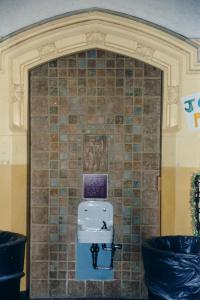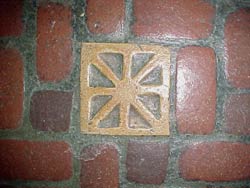Small Home Gazette, Spring 2011
Window to the Past

I’m stingy when it comes to buying books. I don’t like to own a book unless I know I’ll reread it with pleasure or refer to it again and again. So when I wanted to read Robert Winter’s biography of tilemaker Ernest Batchelder, Batchelder: Tilemaker, I ordered it from the public library first.
When the book arrived, I opened it to find a snapshot tucked inside the front cover, which the anonymous photographer had helpfully identified: “This is a picture of the drinking fountain surround at the Keewaydin Elementary School in south Minneapolis, built in 1924 and still in use today.” You can see garbage pails and a hand-lettered school poster on the wall next to the fountain.

Fountain in Keewaydin Elementary School.
Ernest Batchelder is best remembered today for his California tile company. Between 1912 and the late 1930s, his workshop—first in Pasadena, then in L.A.—made field and decorative tile that was installed in California and elsewhere. But he had strong ties to Minneapolis.
Between 1904 and 1909, he directed the summer school at the Minneapolis Handicraft Guild, which served as a school and a professional association for people interested in decorative metalwork, pottery and tilemaking, leatherwork and jewelry making, and bookbinding.

Batchelder floor tile in the Handicraft Guild Building.
One of his first installations ever still graces the lobby floor of the old Guild building in downtown Minneapolis. Batchelder used the designs he created for the Guild’s tiles for the rest of his career.
When the Batchelder Tile Company expanded during the post-World War I building boom, it made perfect sense for Batchelder to open a showroom in Minneapolis. His old friends were artists, architects and well-to-do homeowners.
Minneapolis buildings from the 1920s, both public and private, are filled with Batchelder tile. I’ve had the pleasure of straying into more than one south Minneapolis house, built in the 1920s, to be able to identify a fireplace design straight from Batchelder’s mantel catalog.

Tile arch in the chapel at the College of St. Catherine.
Educational institutions used Batchelder tiles. The University of Minnesota’s original music building has lovely installations, and the College of St. Catherine in St. Paul has stunning examples. The Keewaydin school’s installation is smaller and less ornate. But it is as pretty an example of multicolored Batchelder field tile as you will see anywhere.
Like a lot of school districts, Minneapolis has been suffering financially, and the city has consolidated enrollments and closed school buildings. The Keewaydin school is still open and the tile is still intact. I’ll keep an eye on it. I like to think of the kids seeing that tile every day as they take a drink of water.











